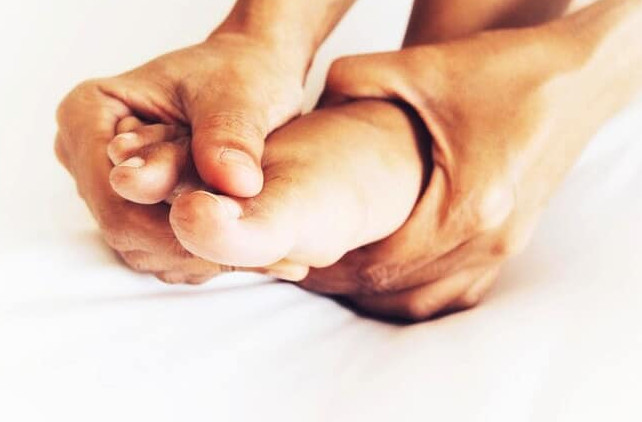Home remedies for treating foot pain without drugs
To avoid any discomfort, it is very important to take good care of your feet to avoid foot pain caused by various reasons.
1. You should massage your feet
In laparoscopic surgery patients, foot massage reduces postoperative pain and anxiety, improves blood circulation, stimulates muscles, and reduces pain.
2. Maintain a healthy weight
Try to reduce your weight with the help of nutritionists, sports trainers, or other experienced people, as even 1 kilogram of weight loss can help treat your back pain.
3. Exercise
Exercise is very effective in reducing leg pain, as it strengthens your legs and lower limbs. Several studies have found that strengthening and stretching exercises improve walking and reduce pain in patients with plantar fasciitis.
Sit and straighten your legs to relieve leg cramps. Pull the leg towards you while holding it. Wrap a towel around your leg if you can’t reach it with your hands. Pain can be reduced through gentle stretching exercises for the Achilles tendon or plantar fascia. Try walking in water if foot pain prevents you from exercising effectively.

4. Your shoes need to be changed
Take a look at your shoes if you have painful feet. Wear comfortable shoes with wide toes and proper cushioning to reduce foot pain. For walking and running, wear good and suitable sneakers.
5. Make sure your feet are clean
Check your feet for ingrown toenails, infections, and other problems regularly.
6. Keep your feet moisturized
The constant exposure to air will dry the skin and cause calluses. If you want to prevent calluses, use lotion or cream after washing your feet and keep your feet moist as much as possible. During the dry winter months, you may need to moisturize your feet several times a day.
7. Corns and calluses should be treated
Having hard and dry skin, corns, and calluses on the soles of your feet can cause bleeding, cracks, and infections. After drying your feet, soak them in warm water for a while and apply a pumice stone or emery stone to remove dead skin cells. Use a lotion to hydrate your skin and wear socks to keep your feet moist.
8. Use night splints
Leg pain during sleep can be relieved by wearing night splints, which keep the legs in a locked position during the night so they are not placed in an uncomfortable position. Plantar inflammation can be treated with night splints.
9. Walking and other activities can be impeded by foot problems, but maintaining your posture and gait can prevent further joint, foot and back issues.
10. Bathe your feet in Epsom salts
Natural muscle relaxants and pain relievers such as Epsom salt have been popularized for external use. After long-term immersion, this salt is broken down into its main components, magnesium and sulfate, which penetrate the body through the skin and affect the main source of pain and inflammation.
Warm water can help open skin pores, loosen tight muscles, and improve blood circulation, making the foot bath more effective.
Simply soak your feet for about 15 minutes in warm water with 1 or 2 cups of Epsom salt.
11. Make use of essential oils
The following therapeutic essential oils can be added to your bath water to create a relaxing bath experience:
It has been shown that lavender oil has anti-inflammatory properties, but more research is needed.
The use of eucalyptus oil has been shown to reduce foot pain, swelling, and inflammation.
Leg pain can be reduced with rosemary oil.
These essential oils can be used in water for soaking, aromatherapy, and massage. Put four drops of eucalyptus, four drops of rosemary, and two drops of mint into a bucket of warm water and soak your feet for 10 minutes. The pain in your feet will soon be relieved.
12. Take a break
If your foot is already hurting, rest it to prevent it from getting worse. For two days, avoid any activity that puts pressure on the foot or aggravates the pain.
If you are sitting or lying down, elevate your legs to help reduce swelling. The underlying injury can worsen if you keep pushing on your painful leg, leading to more severe discomfort.
13. Use of ice
Ice packs temporarily numb nerve endings in the leg, reducing pain. To reduce swelling and pain, wrap a towel around the affected leg and place ice on it for about 20 minutes. To massage your feet, roll a frozen can under your feet for about 10 minutes daily with moderate pressure. Frostbite can occur if ice is placed directly on the skin for an extended period of time.
14. Compression
Tie a bandage around the sore leg to reduce the accumulation of blood and other fluids. It is important to make sure the bandage is tight but not so tight that it restricts blood flow.
15. Elevating the leg above the heart
By elevating the leg above the level of the heart, blood and other fluids are moved away from the injury and help reduce swelling.
To remove excess weight from feet and ankles, remove all jewelry.

16. Eat carrots
For foot pain relief, steam asparagus for a few minutes and eat it, since asparagus is a medicine that relieves joint inflammation or swelling, and because asparagus is a diuretic, it removes excess fluid from your body quickly, thereby reducing inflammation of the joints.
17. Use clove oil
Because clove oil increases blood circulation, it can be used to treat joint pain, nail fungus, and foot pain.
For foot pain, massage your feet with clove oil several times a day, or add three drops to a tablespoon of olive or coconut oil, dilute it, and then massage it into your skin.
18. Get help from vinegar
Prepare two different containers and fill them with equal amounts of water, vinegar, and sea salt to relieve leg pain caused by muscle cramps. Put a towel in a container of hot water, press it, and then place it on your feet for five minutes. Do the same with a bucket of cold water. To relieve leg pain and fatigue, do this three to four times a day.
19. Don’t forget to use hot and cold water
The use of hot and cold water reduces foot pain because hot water increases blood flow and cold water reduces inflammation on the feet. Pour hot water and cold water into two containers and soak your feet in hot water for three minutes and then in cold water for 10 seconds to one minute to relieve foot pain. Dry your feet after repeating this two to three times. For 10 minutes, alternate hot towels and ice packs.
20. Follow these steps to massage your feet:
Clean your feet with lukewarm water and dry them thoroughly.
Water should be lukewarm or hot.
Let your feet soak in warm water for five to ten minutes. Add a few drops of your favorite essential oil to the water.
With one of the towels that you have prepared in advance, dry the feet one by one after ten minutes.
Start by massaging one leg, then wrap the other leg in the second towel to keep it warm.
Start massaging your feet with lotion or massage oil until the lotion is well absorbed.
With one hand, hold the heel and the other, exercise the ankle and joints.
With one hand, press under the foot and with the other hand, press on the foot. As a result, blood flow is increased.
Using one hand on the foot and one hand under the foot, move the hands in opposite directions until the muscles in the legs become soft.
Using the big toe, tap the area under the foot, followed by the rest of the fingers. From the toes to the ankles, start at the toes. Don’t forget the joints and spaces between the fingers.
Separately massage each part of your foot. Place your thumb under the little toe and massage it with the index and middle fingers. Do the same with the other fingers.
Find the four empty spaces between the toes and massage them forward and backward with four fingers.
Make circular movements with your thumb and then tap slowly on the middle and bottom parts of the foot after massaging between the toes.
Slow down your strokes at the end of the massage.
The other leg is massaged after the first leg has been massaged.
Wipe off any excess oil or lotion left on the skin after the massage.
People with diabetes should consult their doctor before performing any of these massages.
Foot pain prevention measures:
In order to prevent foot pain from recurring, you can make the following lifestyle changes:
Maintain a healthy diet.
Exercise moderately every day.
Keep a healthy weight.
Smoking should be avoided.
Consume alcohol and drugs in moderation.
Make sure you get enough sleep.
Movements that are repetitive and impactful should be avoided.
Spend as little time as possible sitting or standing.
Control your blood pressure.
Make sure you wear comfortable clothes and shoes.
Rubber mats are useful if you have to stand for a long time.
Is there a reason why leg pain increases at night?
Poor blood circulation, a neurological problem, or an underlying sleep disorder may cause leg pain at night. If persistent, please consult your doctor.


